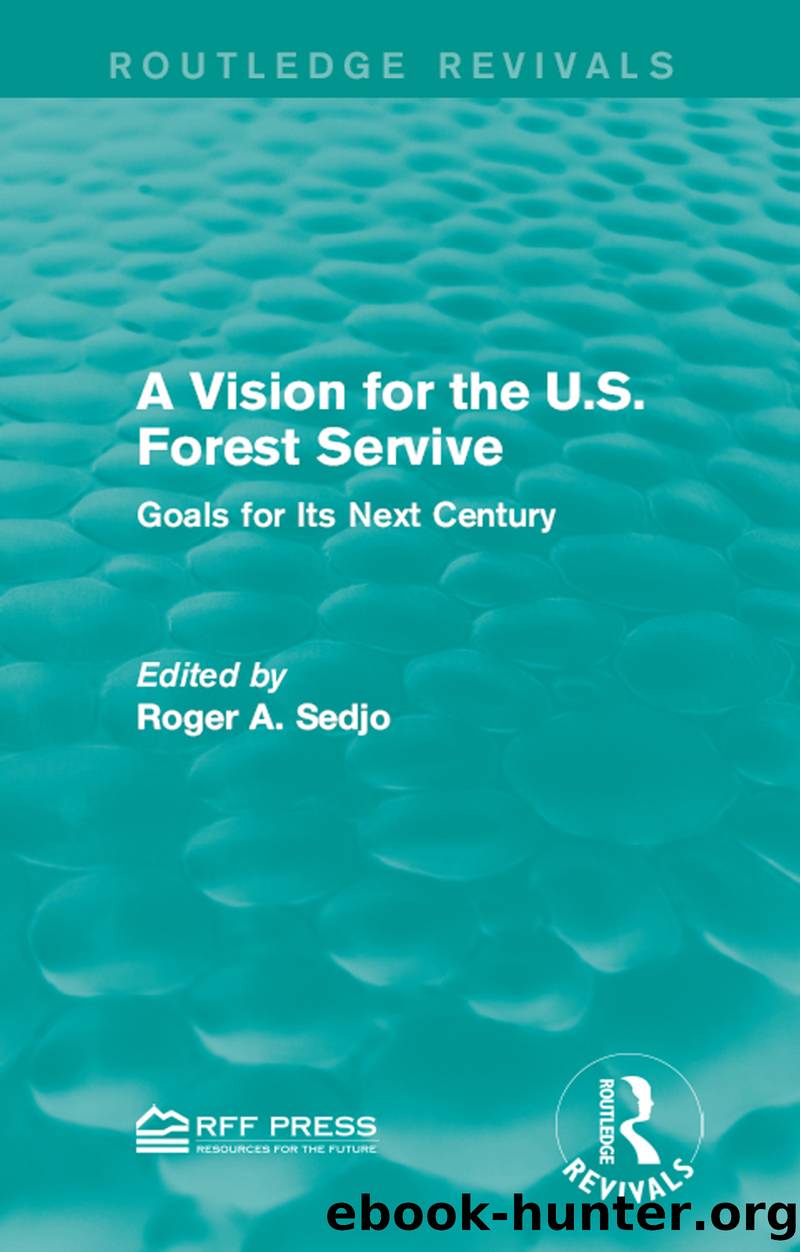A Vision for the U. S. Forest Service by Sedjo Roger A.;

Author:Sedjo, Roger A.;
Language: eng
Format: epub
Publisher: Taylor & Francis Group
Published: 2000-08-15T00:00:00+00:00
Endnotes
Causes for this fall from grace are numerous and complex. Characteristically, Randal OâToole emphasizes that the agency is no longer making money: In the 1990s, the agency lost approximately $2 billion annually by managing the same number of acres that it managed at a profit when Newsweek became nearly breathless with admiration in the early 1950s. OâToole also notes the centralization of the agency that began in the 1970s as an additional contributing factor. Others have focused attention on the standardless multiple-use mandate that grants the agency discretion almost without fetter, but leaves it unable to define its priorities, to do or defend any particular action as comporting with a mandate. (The best discussion of the multiple use act is still that by McCloskey [1961].) Conversation nevertheless seems to focus on demoralization in the ranksâthe agency lacks a âvisionâ of its mission, and its employees are individually and collectively buffeted from one witless paper-pushing exercise to another (Forest Options Group 1998; see also Fairfax 1980).
It is common to observe that reluctance to change policy stems in part from the fact that the protagonists are so well paid off that none of them has much incentive to consider alterations (Leshy 1984). Sax (1984) makes the same point in the same volume, observing that the public lands constitute a âmatureâ policy system in which all the relevant interests are paid off.
Although as Schiff (1960) demonstrates, the agency is a fickle friend of scientific method. Newly designated former chief Jack Ward Thomas made the radical suggestion that the troops could improve their stature simply by telling the truth.
I refer, of course, to Mountains Without Handrails (Sax 1980) and the whole array of Saxâs parks works, discussed in Fairfax (1998).
This is not to say that the emphasis on local decisionmaking disappeared either from the politics or the rhetoric of American life. However, after the defeat of William Jennings Bryan in 1896, the effect of the small town mystique receded as the federal government emerged as the dominant force in public lands and most other policy arenas (discussed in Raymond and Fairfax 1999).
See Camfield v. United States (167 U.S. 518 [1897]), which is not an interpretation of either property clause but in fact a nuisance case: As proprietor, the federal government has a right to protect itself against nuisance.
This fundamental notion of separation of powers is manifest in the Constitution but is even more deeply rooted. In Second Treatise of Civil Government, Locke (1948) observed that legislatures âneither must nor can transfer the power of making laws to anybody else, or place it anywhere but where the people have.â
Compare United States v. Grimaud (220 U.S. 506 [1911]) with Lochner v. New York (198 U.S. 45 [1905]). Lochner named the era of judicial hostility to federal programs and is the subject of an enormous literature. A good place to start is Sunstein (1987).
The President would add a sufficient number of judges to the Court to ensure a protective majority for his programs. From whence cometh the famous âswitch in time that saved nine.
Download
This site does not store any files on its server. We only index and link to content provided by other sites. Please contact the content providers to delete copyright contents if any and email us, we'll remove relevant links or contents immediately.
The Lonely City by Olivia Laing(4584)
Animal Frequency by Melissa Alvarez(4184)
All Creatures Great and Small by James Herriot(4013)
Walking by Henry David Thoreau(3706)
Exit West by Mohsin Hamid(3655)
Origin Story: A Big History of Everything by David Christian(3492)
COSMOS by Carl Sagan(3375)
How to Read Water: Clues and Patterns from Puddles to the Sea (Natural Navigation) by Tristan Gooley(3262)
Hedgerow by John Wright(3130)
The Inner Life of Animals by Peter Wohlleben(3119)
How to Do Nothing by Jenny Odell(3118)
How to Read Nature by Tristan Gooley(3100)
Project Animal Farm: An Accidental Journey into the Secret World of Farming and the Truth About Our Food by Sonia Faruqi(3042)
Origin Story by David Christian(3014)
Water by Ian Miller(2981)
A Forest Journey by John Perlin(2934)
The Plant Messiah by Carlos Magdalena(2767)
A Wilder Time by William E. Glassley(2706)
Forests: A Very Short Introduction by Jaboury Ghazoul(2687)
